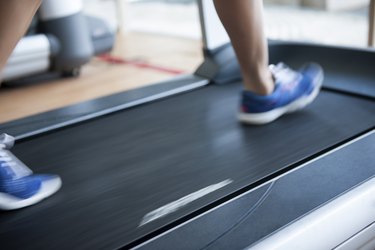
Running improves heart and lung conditioning, burns excess fat, strengthens muscles, improves sleep, and can help overcome depression or other mental problems. A runner does not have to train for 26-mile marathons or try to sprint at Olympic speeds to benefit. All running, at any speed, is beneficial, but speed and length of run affect calorie and fat burning. Consult a doctor before starting any running program.
Always Start Slow
Video of the Day
Start with slow running if you have not been training regularly and work up to a good training pace, depending on your age, physical condition and available time. Alternate walking and running, then move to jogging and running. Even after you decide on a regular training pace, start each run slowly. Kenyans, some of the world's fastest and most fit runners, always start with slow running.
Video of the Day
Speed and Weight
Calorie burning will vary with the speed of the run and weight of the runner. Lisa Balbach, a trainer at Kirtland Community College in Washington, says at an 8-minute-per-mile pace, a 123-pound woman will burn 113 calories in 10 minutes; a 170-pound man will use 150. At a 9-minute pace run, a 150-pound man or woman will burn 131, a 175-pounder 153. Calorie tables from Harvard Medical School and other sources give comparable figures.
Distance
The distance or length of time spent running affects the total calorie burning. For example, a 10-second sprinter will burn more calories in 100 yards than an 8-minute miler, but the miler will use more total calories because he runs for 8 minutes as opposed to 10 seconds. A Nutribase table shows a 160-pound person will burn 368 calories in 30 minutes at a 10-minute pace and 296 at a 12-minute pace but may be able to sustain the slower run longer. Thus running 30 minutes at the faster speed will use 368 calories, but one hour at the more moderate pace will burn 592 calories. Fast may burn calories at a higher rate, but slow may burn more total calories.
Calories and Fat
Calories burned does not directly translate to fat burned. The body's main fuel for energy is glycogen, carbohydrates stored in muscles. When glycogen levels drop, the body burns fat as fuel, so to burn fat you need to reduce glycogen. This will vary with the conditioning of the runner, the amount of stored glycogen and the length of the run. Eating carbohydrates prior to a run will increase glycogen and slow fat-burning. During a long run, the body will burn less glycogen and more fat.
Fat Loss
Fat loss ultimately is decided by the difference in calories burned and calories taken in. A distance-running coach, Pete Pfitzinger, says, "Higher-intensity exercise is better for losing fat because it uses more calories per minute…If you burn more calories, you will lose more fat than if you burn fewer calories. Lower intensity exercise is only better for fat loss if you exercise long enough to make up for the lower number of calories used per minute." A University of New Mexico researcher who compared slow and fast runs with a test subject concluded, "At the higher intensity, the subject burned more total calories, more fat calories and more carbohydrate calories."
- Running Warehouse; Run Like a Kenyan; Scott Douglas
- Distancecoach.com; Fat Facts; Pete Pfitzinger
- American Council on Exercise: Physical Activity Calorie Counter
- MotleyHealth; Health Benefits of Jogging and Running; Jon Wade; March 2011
- University of New Mexico; Fat Facts; Len Kravitz, Ph.D.
- Health and Fitness: 3 Ways Your Body Is Burning Calories
- Nutribase: Exercise Calorie Calculator
- What's Cooking America: Calorie Burn Chart
- Harvard Medical School: Calories Burned in 30 Minutes for People at Different Weights